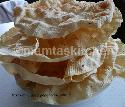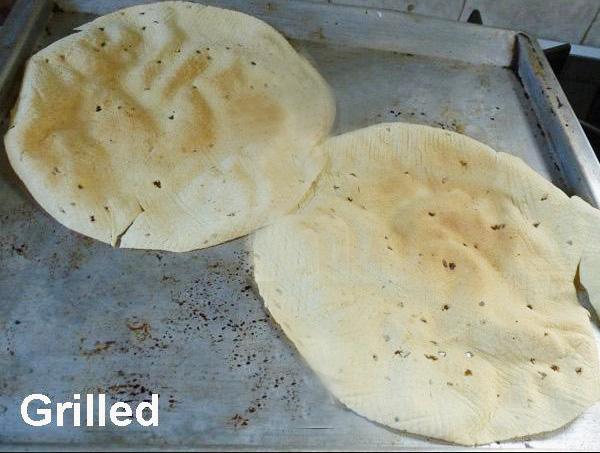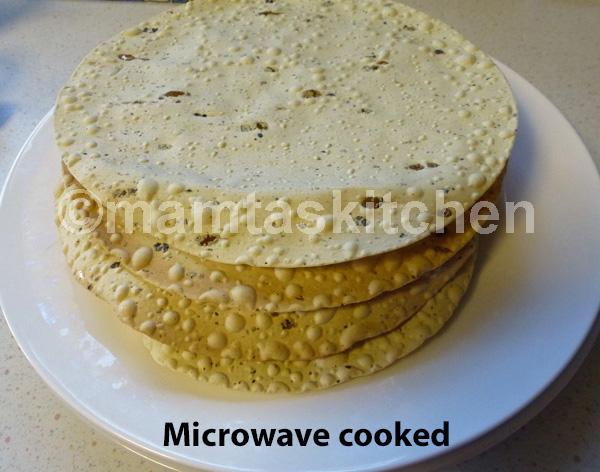How To Cook Papar or Popodoms?
Papad Or Papar, How To cook?
Gupta family
The word poppadums, known as 'papads' or 'papars' in India, the sound being a mix of 'd' and 'r' sounds. The word Poppadums is an English/British invention, perhaps taken from South Indian word 'papadam' or 'paparam'. They are paper thin, round wafers made with various dough’s, with spices and herbs. The most popular ones in North Indian cuisine are made with either Urad or Mung dal, with salt and black pepper. In India, rice, sago and potato papads are popular, often as a snack. Mini Papads are sold as crisp snacks, in small pakets . They come in all sizes, from small bite sized to huge ones that fill a large dinner plate. They are crunchy like crisps. Lentil ones can be roasted/grilled/deep fried/microwave cooked, the rest are deep fried.
In UK restaurants, they are served mostly as a starter, with chutney, dips, finely chopped Kachumbhar Salad and yoghurt. In Indian homes, they are mostly eaten as part of the main meal. A very popular starter in many restaurants in western India is "Masala Pappad"; spread chopped tomato, coriander and onion on small pieces of deep-fried papad, then sprinkling some Chat Masala and chopped green chillies on top. Make this just before serving, or papad will get soggy.
In Rajasthan, serving papads traditionally heralds the end of a meal. In older days, this was quite a strict rule. If you served papads at the beginning of a meal or with a meal by mistake, people would get up from the table, abandoning the meal. There are many tales about whole wedding parties leaving their meal because some poor host unwittingly served them papads at the beginning, which they considered an insult!
Once opened, store them in a plastic, airtight bag/box. Otherwise, they will deteriorate, becoming brittle quickly due to loss of moisture.
Ingredients
Varieties of Papads:
Lentil like Urad and mung (cook any method)
Mathia Dal flour (cook any method)
Potato flour (deep fry)
Rice flour (deep fry)
Sago/Tapioca (deep fry)
Ragi Finger Millet
Jowar flour
Mixed
Flavours of Papads
Black pepper
Cinnamon
Cloves
Coriander leaves
Cumin
Garlic
Green chilli
Green chilli and garlic
Mixed flavours
Mixed masala
Pickle
Plain
Red Chilli
Shrimp
Papads also contain raising agents like soda bicarbonate or 'Khar'
Instructions
Grilling: Heat the grill. Place popadoms/papars on a tray and place the tray under a pre-heated grill, 3-4 inches below the heat source. As soon as a few blisters appear or they become opaque, turn them over and repeat the process. If the grill is hot, they cook very fast - in a few seconds, so don't leave them and go away to do other things!
Deep frying: This, the most unhealthy way, has unfortunately become the most popular way of cooking popadoms/papars in the West. Heat the oil in a wok or karahi to almost smoking point. If frying large popadoms/papars, fry one at a time. You can cut them into halves or quarters. They fry and swell up very fast, so you have to be fast in removing them from the oil: Hold one popadom with metal tongs (Chimata) and slide it into the oil. Turn it over quickly once, and then lift out of the oil with the tong. Gently shake off the excessive oil and leave it to drain on kitchen paper/old newspaper. Tiny, snack popadoms/papars can be fried a few at a time, using a slotted spoon. Be careful, fry only a few at a time. They 'swell up' quite a bit and become difficult to handle if you fry too many at once. Experiment with how many you can manage. When frying multiple popadoms/papars, press them gently into the oil, to ensure that every corner is cooked properly. Remember, they cook very fast, in seconds.
Roasting on open gas flame or charcoal fire (for lentil popodoms only): Hold the edge of a popodom/papar with tongs and flick it over a medium flame/fire, back and forth, moving quickly, until all parts of popodom/papar are cooked. Quick turning is necessary to prevent burning. When popodom/papar curls up and changes colour to a lighter shade or becomes opaque, it is cooked.
If you have a gas top roasting plate, as shown in last two photos, you can roast vegetables on it. This method gives them the flavour close to roasting on charcoals.
Cooking in a Microwave
Place one or two popodoms/papars in the microwave oven (800-1000). Cook on full for 20-30 seconds. Flip over and cook again for 20-30 seconds. If they are thicker popodoms/papars, they may take longer to cook. This method is best for lentil popodoms/papars. Sometimes popodoms/papars will not cook in a microwave. This is because when they are too dry or contain very little oil within, there is nothing to conduct the ‘microwaves’ through them. They can be microwave cooked well by smearing a bit of water on them - say by wiping them with a wet cloth. This phenomenon is wittingly used to make smart Popodom/papar Rolls in a microwave.
Some Indian stores sell a hand-held grill tray with a metal mesh, which can be placed over a direct flame and it is quite handy for cooking popodoms/papars when you don’t have access to a grill or microwave. In fact, masala papar can be made easily on this grill tray, by spreading chopped onion and tomato after roasting, while popodom/papar is still on this grill.
Cooking on an electric cooker
Heat it to moderately hot and then use the same method as for gas. If you have wire rack that you can place over the electric ring, it is even easier to cook them.
While still hot, fried or roasted popodoms/papars can be quickly folded into half and then quarter, so they will fit in a Tiffin box or lunch box- tip from Anupam Saurabh.
Cooking in a toaster
Cut papads in halves. Place 1 half on each side of the toaster. Toast on 'light' toast setting'. They burn fast, so keep an eye on them.
Papad cones; Cut papads into 4 and roast each piece one by one. while still hot, quickly fold each piece into a cone. This makes it easier to serve them in large numbers on one plate- see picture of papad Cone.











